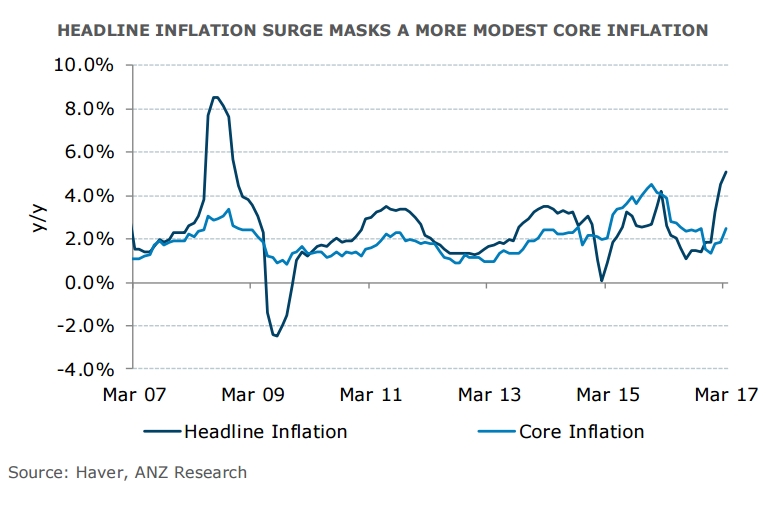Malaysia's consumer price inflation hit an eight-year high in March, data released by the Malaysian statistics department showed on Wednesday. Malaysia’s headline inflation accelerated to 5.1 percent in March, from 4.5 percent in the previous month. The rise was slightly below the forecast in a Reuters poll at 5.2 percent.
Low-base effect and higher retail fuel prices exacerbated the rise in headline inflation. Fuel prices have a weighting of 7.8 percent in the CPI basket and a 48 percent y/y average increase in domestic fuel prices and the attendant knock-on impact on transport costs was seen as the main driver. Core inflation, which excludes volatile items of fresh food and administered prices of goods and services, remained stable at 2.5 percent y/y.
For April, inflation is likely to remain elevated. Notwithstanding increases in energy and food prices, the prices in other categories have remained relatively benign. Analysts expect core inflation to stay relatively modest, as growth is likely to remain under pressure. Growth dynamics also do not point to the emergence of strong demand-pull inflationary pressures.
"We expect headline inflation to be more volatile from April onwards as fuel prices, which have a weighting of 7.8% in the CPI basket, have been adjusted on a weekly basis since 30 March. We expect the weekly fuel adjustments month-to-date to add around 1.8ppt to April’s headline CPI print," said ANZ in a report.
Bank Negara Malaysia (BNM) said headline inflation will be "relatively high" in the first half of 2017 on higher fuel prices, but expects it to dip in the second half. BNM expects headline inflation to be 3 to 4 percent in 2017, against 2.1 percent last year. Accordingly, today's inflation spike is not expected to push the central bank to change its stance on monetary policy.
"BNM will likely peer through the inflation ascent and the central bank is likely to maintain its policy rate at 3% through 2017," adds ANZ.
USD/MYR was trading 0.29 percent lower on the day at around 4.3960 at 1130 GMT. Price action has been ranging since Jan 2017 and we see scope for downside. Price action has dipped below the daily Ichimoku cloud. Major support on the downside is seen at 4.2931 which is the 200-day moving average.
FxWirePro's Hourly USD Spot Index was at -67.1594 (Neutral) at 1130 GMT. For more details on FxWirePro's Currency Strength Index, visit http://www.fxwirepro.com/currencyindex.



 Why central banks should stop raising interest rates
Why central banks should stop raising interest rates  Governments have been able to overrule the Reserve Bank for 80 years. Why stop now?
Governments have been able to overrule the Reserve Bank for 80 years. Why stop now?  Germany decriminalised cannabis: why the UK should consider doing the same
Germany decriminalised cannabis: why the UK should consider doing the same  Why is toddler milk so popular? Follow the money
Why is toddler milk so popular? Follow the money  Vladimir Putin’s gold strategy explains why sanctions against Russia have failed
Vladimir Putin’s gold strategy explains why sanctions against Russia have failed  Inflation: why prices look likely to stay high in the UK and Ireland, and what that means for mortgages
Inflation: why prices look likely to stay high in the UK and Ireland, and what that means for mortgages  Interest rates are expected to drop but trying to out-think the market won’t guarantee getting a good deal
Interest rates are expected to drop but trying to out-think the market won’t guarantee getting a good deal  Inflation: I've been analysing the Bank of England's forecast over the past two years – here's how they got it wrong
Inflation: I've been analysing the Bank of England's forecast over the past two years – here's how they got it wrong  How cuts to marginal income tax could boost the UK’s stagnant economic growth
How cuts to marginal income tax could boost the UK’s stagnant economic growth  If central banks don't start cutting them soon, it could actually increase inflation
If central banks don't start cutting them soon, it could actually increase inflation  How hybrid work is reinventing management
How hybrid work is reinventing management  Be wary of the ‘vibes’: positive investor sentiment doesn’t necessarily match the true value of stocks
Be wary of the ‘vibes’: positive investor sentiment doesn’t necessarily match the true value of stocks 






























